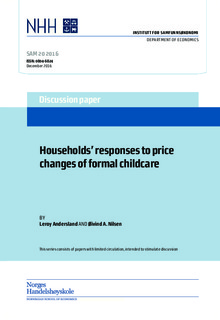| dc.contributor.author | Andersland, Leroy | |
| dc.contributor.author | Nilsen, Øivind A. | |
| dc.date.accessioned | 2017-01-18T07:15:48Z | |
| dc.date.available | 2017-01-18T07:15:48Z | |
| dc.date.issued | 2016-12 | |
| dc.identifier.issn | 0804-6824 | |
| dc.identifier.uri | http://hdl.handle.net/11250/2427574 | |
| dc.description.abstract | The current understanding about how households respond to price changes in formal
childcare is not extensive. This study examines this response through a 1998 reform in
Norway that introduced a money transfer to families who did not send their child to
childcare. This cash-for-care reform raised the price of formal childcare relative to its
alternatives by about 115% for 1–2 year olds but not 3–5 year olds. Using household
surveys conducted before and after the reform the analysis reveals that childcare attendance
fell by 13.7 percentage points because of the reform. The results also indicate
that the most important alternative to formal childcare is parental care. Furthermore,
households of low socioeconomic status are more price sensitive, with the main
substitute mode of care for this group being parental/relative care, whereas for high
socioeconomic status families the substitutes include day parks and nannies as well as
parental care. | nb_NO |
| dc.language.iso | eng | nb_NO |
| dc.publisher | Institutt for samfunnsøkonomi, NHH | nb_NO |
| dc.relation.ispartofseries | DP SAM; 20 | |
| dc.subject | Public Policy, Cash Incentives, Childcare, Difference-in-Difference | nb_NO |
| dc.title | Households’ responses to price changes of formal childcare. | nb_NO |
| dc.type | Working paper | nb_NO |
| dc.subject.nsi | VDP::Samfunnsvitenskap: 200::Økonomi: 210 | nb_NO |
| dc.source.issue | 20 | nb_NO |
